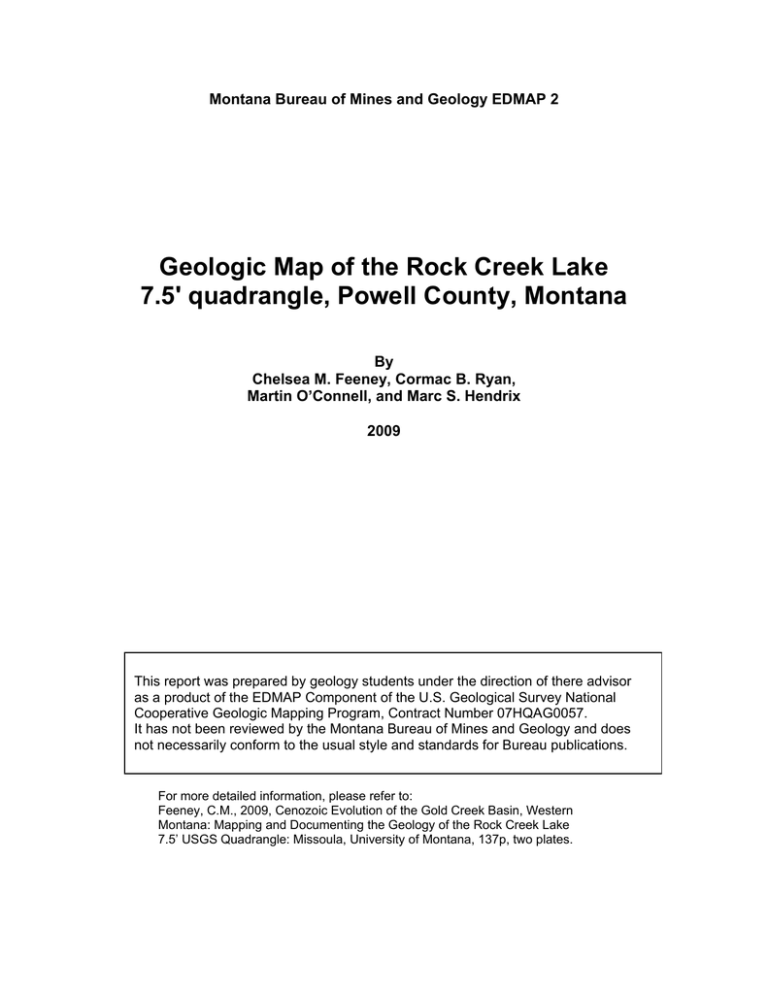Geologic Map of the Rock Creek 1.5` quadrangle, Powelll
advertisement

Montana Bureau of Mines and Geology EDMAP 2 Geologic Map of the Rock Creek Lake 7.5' quadrangle, Powell County, Montana By Chelsea M. Feeney, Cormac B. Ryan, Martin O’Connell, and Marc S. Hendrix 2009 This report was prepared by geology students under the direction of there advisor as a product of the EDMAP Component of the U.S. Geological Survey National Cooperative Geologic Mapping Program, Contract Number 07HQAG0057. It has not been reviewed by the Montana Bureau of Mines and Geology and does not necessarily conform to the usual style and standards for Bureau publications. For more detailed information, please refer to: Feeney, C.M., 2009, Cenozoic Evolution of the Gold Creek Basin, Western Montana: Mapping and Documenting the Geology of the Rock Creek Lake 7.5’ USGS Quadrangle: Missoula, University of Montana, 137p, two plates. ROCK CREEK LAKE 7.5’ USGS QUADRANGLE EDMAP #: 07HQAG0057 C. M. Feeney ROCK UNIT DESCRIPTIONS QUATERNARY Qmt Anthropogenic Deposits (modern) Placer mine tailings, mine dumps, and slag piles. Sluicing operations left outcrops of Tr exposed and long parallel ridges of reworked glacial till. Holocene and Pleistocene Epochs Qal Alluvium and Glacial Outwash Characterized by moderately- to poorly-sorted, subrounded to rounded gravel- to cobble-sized clasts and medium to very coarse sand, interbedded with fine sand and silt; clast composition of glacial outwash and alluvial deposits is similar to that of Qgp glacial till, primarily granite and quartzite clasts, but clasts are slightly better rounded and fine-grained matrix is commonly absent. Deposits are located along active channels of creeks and intermittent streams and farther north and east of the RCL map area in the GCB and DLB. Cross-bedding and graded beds in glacial outwash are common. Qgp Glacial till of Pinedale Glaciation Characterized by high, sharp-crested lateral moraines with steep slopes, locally greater than 30°; Qgp moraines form ridges on either side of currently active streams (e.g. ridges just north of Pike’s Peak Creek and Tin Cup Joe Creek, Plate 1), recessional moraines, and/or less pronounced terminal moraine complexes (at the easternmost extent of Pikes Peak Creek and Rock Creek in the northeast corner of the RCL map area). Till composed of unconsolidated, poorly sorted, angular to sub-angular, boulder-sized clasts, composed almost entirely of granite and granodiorite. In the Yellowstone/Teton area, Licciardi and Pierce (2008) constrained the Pinedale glaciation at approximately 18,000 10 16,000 years using cosmogenic Be surface exposure ages on boulder till. Qgb Glacial till of Bull Lake Glaciation Characterized by low to moderate, round-crested, moderate to poorly developed lateral moraines (e.g. just north of La Marche Creek, Robinson Ridge and ridges north and south of Taylor Creek, Plate 1). Younger moraines locally crosscut Qgb moraines. The majority of till is composed of matrix-supported, sandy and silty cobble and boulder gravel of local quartzite and igneous rocks; characterized by a low density of extremely weathered granite boulders (Mutch, 1961). Commonly large boulders are partially to fully buried; surfaces of granite boulders are friable. Such rounded and poorly defined moraine crests suggest that Qgb moraines are related to an older glacial maximum advance interpreted to be the Bull Lake Glaciation. Similar shaped moraines have been described by Knoll (1977) and Elison (1981) for glacial moraines associated with the Bull Lake glaciation in mountain ranges in Idaho and NW-Montana. Licciardi and Pierce (2008) date the Bull Lake glaciation at approximately 157,000 - 136,000 years 10 using cosmogenic Be surface exposure ages on boulder till. TERTIARY Tsc Sixmile Creek Formation Miocene (Barstovian) to Pliocene gravel fan deposits and debris flows on upper Renova Formation pediment surfaces. Unit is preserved on isolated terraces between erosional drainages (Berg, 2004) and consists of cobble-sized clasts of mixed composition including metamorphic schist, slate, argillite and primarily quartzite. Quartzite cobbles exhibit percussion or “chatter marks” which indicate fluvial transport rather than transport via mud-supported debris flows. Unit overlies and locally truncates the upper Renova Formation ash deposits along an angular unconformity, although identifying the unconformity in the field is difficult due to lag gravels that mantle the hillsides. Tr Upper Renova Formation - sedimentary deposits Primarily mudstone, siltstone, and very fine sandstone composed mostly of volcanic ash (Eocene, Oligocene, or Miocene; Lewis, 1998). Locally, unconsolidated sand and ash deposits overlie organic-rich mudstone. Locally abundant fossils and roots casts are preserved in ash. Primarily flat-laminated with local cross-beds in sand deposits and micro-laminated ripples. Trc Upper Renova Formation continued Isolated sandstone and conglomerate deposits vary from well sorted, rounded, very fine to fine sand-sized grains to poorly sorted, angular, medium to very coarse sand and granule-sized grains. Deposits are poly-mineralic and primarily composed of quartz, feldspar, biotite, muscovite, and lithic fragments. Many grains are coated with isopachous quartz cement. Isolated outcrops contain abundant cross-beds and graded bedding throughout; petrified wood present in some locations. Tmpg Mount Powell porphyritic granite Granite composed primarily of polycrystalline quartz (locally strained), plagioclase, muscovite, biotite, and microcline - referred to as “2-mica” granite. CRETACEOUS Kmrg Royal Stock granodiorite Non-foliated granodiorite primarily composed of zoned plagioclase and strained polycrystalline quartz, K-spar, biotite, muscovite, and hornblende. Protomylonitic fabric present along southeastern margin of intrusion where unit is composed of biotite-hornblende granodiorite with proto-mylonitic gneissic banding. Kc Colorado Group Sandstone member consists of subangular to rounded, well sorted, medium sized sand, grain supported; primarily composed of chert, quartz, plagioclase, muscovite, lithic fragments. Shale member consists of recessive-weathering black shale, fissile and friable, locally weathered to red color. Conglomerate member consists of gravel- to cobble-sized clasts composed of quartzite, chert, sandstone fragments and minor amounts of muscovite with calcite cement. Kk Kootenai Group Mudstone breccia member (Kk1 or Kk3?) consists of gravel-sized clasts composed of silt-sized quartz grains with minor amounts of muscovite; grains are altered and iron-stained. Limestone member (Kk2 or Kk4?) exhibits remnant fossils (gastropods?). Both members are extremely brecciated and hydrothermally altered in the map area due to local faulting. PERMIAN Pp Phosphoria Formation This unit is metamorphosed in the map area and highly jointed in fault zones. Slate/argillite member is extremely finely-laminated and consists of alternating light and dark bedding with lenses of silt sized grains; Schist member is located particularly along the western extent of Emery Ridge in the RCL map area and consists of nodules of silt with foliated muscovite, monocrystalline quartz and accessory garnet; Slate hornfels member is dark purple in color and appears “spotted”, thin section reveals foliated muscovite and silt-sized monocrystalline quartz (Meade Peak Member?); Mutch (1960) mapped this “spotted slate” as Amsden Formation. PENNSYLVANIAN IPq Quadrant quartzite Quartzite, vitreous luster, recrystallized with sutured grains (Mutch, 1960), 99% quartz, brittle, very hard. Unit is highly sheared and brecciated along fault zones, especially in the NW corner of the map area, along Emery Ridge; unit is commonly red; quartzite fragments composed of microcrystalline quartz with minor amounts of muscovite mica. MISSISSIPPIAN Mm Madison limestone Limestone primarily metamorphosed into marble in the map area, massively bedded, and cliff-forming. Unit is highly brecciated and karstified along fault zones with open framework pores; some outcrops contain chert nodules locally exceeding 10 cm. Unit has undergone extreme hydrothermal alteration where in contact with igneous intrusive bodies in the mapping area. CAMBRIAN Єh Єsh Hasmark Group Due to its proximity to the Royal Stock intrusion in the map area, this unit is metamorphosed, recrystallized, and hydrothermally altered in most locations. Basal member (Meagher Formation?) consists of altered yellow dolomite; Middle member (Park Formation?) is composed of alternating micro-lamina consisting of dark purple and green calcareous slate/argillite; pyrite crystals and muscovite present in veins; fresh surfaces characterized by sulfurous odor; Upper member (Pilgrim Formation?) increasingly siliceous, white/light tan, sucrosic, and friable towards top; garnet and tremolite present in altered sections; jointing and breccia present along fault zones; Contact between Hasmark and Silver Hill Formations is transitional over ~5m and is interstratified with hornfels and tremolite marble (Mutch, 1960). Silver Hill Formation Units exposed north of Rock Creek Lake: non-calcareous facies composed of extremely fine micro-laminated argillite with alternating layers of silt and fine sand-sized monocrystalline and polycrystalline quartz, biotite, muscovite, and hornblende; calcareous facies composed of matted, brown-grey, wavy microlaminations, with calcareous mud “pods”. Units in the south central portion of the map area: pale-green recrystallized calcsilicate; K-spar and plagioclase silicate minerals; muscovite and zoisite present as a result of green-schist facies metamorphism; tremolite present due to extensive hydrothermal alteration, hornfels composed of diopside (Mutch, 1960). Micro-laminated argillite with siliceous mud “pods” exposed locally. Єf Flathead quartzite Quartzite unit consisting of polycrystalline quartz with trace amounts of rutile; contains local micaceous shale partings and well-developed jointing throughout unit; vitreous white, pink, tan and somewhat mottled in color; sugary texture with remnant bedding visible in hand sample. PRECAMBRIAN BELT SUPERGROUP (Mesoproterozoic) Yb Belt Supergroup 1) Light-colored, well sorted, fine to medium grained quartzite beds that contain ripple marks and abundant cross-beds throughout; cross-beds are continuous and lack mud drape between truncated foresets and are characteristically purple/dark gray and white-colored along foresets. Detrital mica is locally common (Pilcher Fm). 2) Light- to dark-colored quartzite locally interbedded with micaceous phyllite and argillite; mica is interpreted to be detrital; unit contains chlorite and exhibits local parallel bedding, cross-bedding, and ripple marks (Garnet Range Fm). References cited Berg, R.B., 2004, Geologic map of the Deer Lodge and Conleys Lake 7 ½’Quadranges, Powell County, southwestern Montana: Montana Bureau of Mines and Geology Open-File Report 509. Elison, M.W., 1981, Relative dating of major moraines of the southeast Jocko valley: Northwest Geology, v. 10, p. 20-31. Knoll, K.M., 1977, Chronology of alpine glacier standstills, east-central Lemhi range, Idaho: Special publication of the Idaho Museum of natural history, Pocatello. Licciardi, J.M., and Pierce, K.L., 2008, Cosmogenic exposure-age chronologies of Pinedale and Bull Lake glaciations in greater Yellowstone and Teton Range, USA: Quaternary Science Reviews, v. 27, p. 814-831. Lewis, R.S., 1998, Geologic map of the Butte 1° x 2° Quadrangle: Montana Bureau of Mines and Geology Open-File Report 363. Mutch, T. A., 1961, Geologic map of the northeast flank of the Flint Creek Range, western Montana: Montana Bureau of Mines and Geology Special Publication 22 (Geologic Map 5), 1:48,000. Mutch, T. A., 1960, Geology of the northeast flank of the Flint Creek Range, western Montana: Ph.D. thesis, Princeton University, 159 p. Montana Bureau of Mines and Geology EDMAP 2 - Plate 1 of 2 Tsc This report was prepared by a geology student under the direction of his advisor as a product of the EDMAP Component of the U.S. Geological Survey National Cooperative Geologic Mapping Program, Contract Number 07HQAG0057. It has not been reviewed by the Montana Bureau of Mines and Geology and does not necessarily conform to the usual style and standards for Bureau publications. A’ For more detailed information, please refer to: Feeney, C.M., 2009, Cenozoic Evolution of the Gold Creek Basin, Western Montana: Mapping and Documenting the Geology of the Rock Creek Lake 7.5’ USGS Quadrangle: Missoula, University of Montana, 137p., two plates Tsc Trc MAP UNIT DESCRIPTIONS Qmt - Modern Anthropogenic Deposits - placer mine tailings, mine dumps, and slag piles Qal - Quaternary alluvium and glacial outwash Tsc Tsc B Qgp - Quaternary glacial till Pinedale Qgb - Quaternary glacial till Bull Lake Tsc e ery g d i R Tsc - Sixmile Creek Formation - terrace and pediment gravels, debris flows Em Tr - Upper Renova sedimentary deposits - volcanic ash beds and sandstone, conglomerate channel deposits Trc - Upper Renova channel deposits - sandstone, conglomerate Tsc Tmpg - Tertiary granitic rocks - Mt. Powell porphyritic granite Kmrg - Cretaceous granodioritic rocks - Mt. Royal granodiorite Tsc Kgs - Cretaceous Golden Spike Formation - in cross section only Kc - Cretaceous Colorado Group - siliciclastic Kk - Cretaceous Kootenai Formation - mudstone, limestone Pp - Permian Phosphoria Formation - slate, argillite IPq - Pennsylvanian Quadrant - quartzite Mm - Mississippian Madison Group - carbonate Ch - Cambrian Hasmark Group - carbonate Csh - Cambrian Silver Hill Group - argillite, and carbonate A Cf - Cambrian Flathead Quartzite Yb - Precambrian Belt Supergroup - quartzite and argillite Pilcher and Garnet Range Formations Pike’s Peak MAP SYMBOLS o 25 L s C R bedding 25 25 # Geologic structures I overturned bedding joints breccia overturned anticline ( ( ( established thrust ( ( ( concealed thrust ( ( ( inferred thrust inferred contact established normal perennial stream concealed normal intermittent stream Rd 5168 Robinson Ridge inferred normal jeep trail FS 302 USFS road maintained Tr 146 pack trail 4 4 4 detatchment R av al li M ou nt ai n GEOLOGIC MAP OF THE ROCK CREEK LAKE 7.5' QUADRANGLE POWELL COUNTY, MONTANA B’ USGS Topographic Map and Seamless DEM Ü 0.5 0 1 Kilometers 2 Contour Interval = 50 meters by Chelsea M. Feeney, Cormac B. Ryan, Martin O'Connell, and Marc S. Hendrix 2009 Montana Bureau of Mines and Geology EDMAP 2 - Plate 2 of 2 This report was prepared by a geology student under the direction of his advisor as a product of the EDMAP Component of the U.S. Geological Survey National Cooperative Geologic Mapping Program, Contract Number 07HQAG0057. It has not been reviewed by the Montana Bureau of Mines and Geology and does not necessarily conform to the usual style and standards for Bureau publications. NE 3,000 A’ 7,000 Qgp Mm 6,000 5,000 Tsc Tsc Tsc Tr Kmrg 2,500 2,000 Tsc 1,500 4,000 2,000 1,000 M.S.L. 0 500 Kgs 0 M.S.L. CROSS SECTION B-B’ ROCK CREEK LAKE 7.5’ USGS QUADRANGLE N 1,000 Tr BEND IN SECTION 3,000 ELEVATION IN METERS ABOVE M.S.L. 8,000 OLD STAGE ROAD 9,000 ELEVATION IN FEET ABOVE M.S.L. C.M. Feeney, 2009 A USFS RD 645 10,000 CROSS SECTION A-A’ ROCK CREEK LAKE 7.5’ USGS QUADRANGLE SW C.M. Feeney, 2009 S 12,000 11,000 B’ 3,500 3,000 9,000 8,000 7,000 6,000 Pq Pq Mm Pp Pq Pp Pq Pikes Peak Crk Qgp Kk Pp Pq Qgp Mm Qgp Rock Creek Lake Ch Mm Qgp Yb Csh 4,000 3,000 2,000 1,000 Qgp 2,500 2,000 Csh 5,000 1,500 Kmrg BEND IN SECTION ELEVATION IN FEET ABOVE M.S.L. 10,000 Tmpg Kmrg 1,000 500 For more detailed information, please refer to: Feeney, C.M., 2009, Cenozoic Evolution of the Gold Creek Basin, Western Montana: Mapping and Documenting the Geology of the Rock Creek Lake 7.5’ USGS Quadrangle: Missoula, University of Montana, 137p., two plates ELEVATION IN METERS ABOVE M.S.L. B




